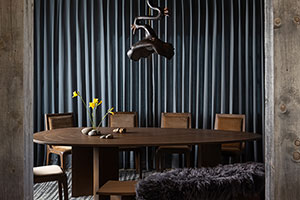Gail Cook
+ Written by Alisan Peters
+ Photography by Latham Jenkins

Gail Cook doesn’t recall how or exactly when the “collector’s bug” bit her. Or if it even did. “I think I was born a collector,” she says. “When I was young, I collected many different things: rocks, stamps, shells, trading cards, fossils, little plastic horses; I don’t know where it came from.”
Born in Boston, raised in Omaha and having lived in Dallas since the late sixties, she and her husband, Dan, bought their Jackson Hole property in 1992, at the confluence of the Snake and Gros Ventre rivers. In the home they built there, they have lovingly furnished it with treasures from around the world.
“You really have to do your homework,” she says of collecting. “You are more likely to find me in antique shops or at auctions than anywhere else. I learn about my world by collecting. When I see something, it’s just an instinctive reaction, but it’s driven by a love of craft and the uniqueness of the item. I like the thought of preserving them; I’m just the caretaker for a while.”

They’re delicate enough to be retired from their duty now, but these Swiss and German nutcrackers were accumulated over time for the beauty of their craftsmanship. Carved from various woods, some have animal heads; some represent people. Most were purchased at different antique shops throughout the U.S., and they’re likely over 100 years old.
Produced by the Shoshone Furniture Company out of Cody, Wyoming, these authentic Molesworth pieces are beautiful examples of that iconic style. Whether sofas, club chairs, tables or cocktail stands, Cook says her collection is from the 1930s, pieces that were not mass-produced as they later were in the 1940s. Burled wood legs, carvings, brass-stud nails and leather detailing provide the backdrop for beautiful Chimayo patterns gracing the cushions, a style still woven by the Chimayo tribe today. Cook’s contact person for repairs even gives weaving lessons, on occasion, at the Smithsonian. Although the pieces look like a set, Cook found them in disparate locations, including a Christie’s auction in New York, Fighting Bear Antiques in Jackson and at the Coeur d’Alene Art Auction in Idaho.


“These are mostly Wyoming branding irons,” says Cook. They were collected one at a time, then fashioned into chandeliers made of copper by Jeff Morris at Heart Four Ironworks. The sconces seen in the background also have branding iron flourishes.
Dating from the 1880s and 1890s, Cook’s bear furniture collection is a happy marriage of whimsy, function and peasant lore. The bear Cook christened “Atlas” performs double-duty as pedestal for the tabletop and sidekick for the second sculpture, a dancing bear. Made of carved wood and fitted with glass eyes, Cook’s bear brigade serves as supports for chairs, benches, hat racks and even her grandfather clocks, one of which is detailed on the next page.
“These were a real find,” Cook says. “Our builder, Mike Beauchemin, said that the doors he could source for our home, Bear Lodge, wouldn’t convey the 1930s hunting-lodge theme that we were working toward. What he was able to find he couldn’t make look old enough. We happened to be on a trip in Toledo, Spain, and we found 65 of these doors—they’re three to four inches thick—with their great hardware and metal studs. Each one is different in some way.” Beauchemin, since retired to Florida, constructed the Fighting Bear Antiques structure and Snake River Grill among other Jackson-area buildings.


Cook’s excitement really kicks up when she talks about these quite rare and unusual chandeliers she found in Germany. They’re of Swiss, German and Austrian origin and used to hang in hunting lodges. In fact, the female figure is Diana of the Hunt. The male figure is clearly a hunter with his shotgun, holding his pipe and sporting a watch fob. Both are carved from wood and came fitted with gas lamps that Cook converted to electrical. Their antler “wings” serve as a platform for the lamps. The smooth wood base is carved in the shape of a crest; it would often be inscribed with the hunter’s name, honoring the one who harvested the animal. The lampshades on the male figure chandelier are made of green glass.
Cook found this gambling wheel in Las Vegas. It is made of wood and metal, with glass panels circling the wheel. A series of racehorses grace the panels, brilliantly colored by reverse painting against the glass, a technique that stems from as far back as the Middle Ages. The technique both protects the artwork behind it and makes it easy to keep the glass clean without causing damage to the paintings. Cook’s kids swear that a bullet had to have made the hole in one of the glass panels.
This bear-adorned grandfather clock is one of Cook’s favorite pieces. She installed it in Cub Cabin (now a guesthouse), where they lived while the main house was being constructed. She calls it an “exceptional piece,” one that dates from the late 1800s. It came to her by way of a telephone call from someone who had seen an article on the Cooks in Architectural Digest. The caller’s grandfather had bought the clock, its carved bears clambering toward the clock face, in Yellowstone. The family had decided to sell it, and Cook’s caller “ … wanted to know if we’d like to buy it. I said, ‘Yes!’ ” Cook relates, “and in a way, we were able to bring this beautiful clock back to its original home.”
With about a dozen on the mantelpiece and another few in her great room, Cook became enamored of these pot-bellied castings after a trip to the Forbes Museum in New York. “Forbes created many collections, but his loving cups really caught my eye,” she says. They served as trophies back in the day, for golf matches or regattas. Right after seeing his collection, I stumbled across a cup with horn handles and thought, gee, that looks like Wyoming. I bought it to use as a vase, but I continued to find them and so I put together my own collection.”


This collection of Curtis’ beloved photographs is one of two collections that Cook owns. Her goldtone photographs, including the beloved “Canyon de Chelly” and “The Vanishing Race,” are kept behind glass in frames that Curtis handcrafted himself. The photogravure portraits pictured above are arrayed behind an elkskin-covered Molesworth conversation grouping in a sitting room off the bedrooms. Each frame was created to correspond to Curtis’ own frames on the goldtones.
Painter, writer, educator and famed Native American sculptor Fritz Scholder created this life-size bronze statue. The Cooks have quite a few of Scholder’s pieces, and this one had a favored status at Cub Cabin while the larger home was being built. Cook tells of the snowstorm that filled the eye sockets of the sculpture, an experience she describes as startling. “Wrapped in his blanket,” Cook says, “he’s kind of the physical embodiment of the Curtis photographs. I like to think of him out there, guarding our home.”







